DTM-Based Analysis of Hot Topics and Evolution of China’s Energy Policy
Abstract
1. Introduction
2. Literature Review
3. Research Methods and Materials
3.1. Research Methods
3.1.1. Topic Popularity Calculation
3.1.2. Social Network Analysis
3.2. Research Materials
3.2.1. Data Acquisition
3.2.2. Sample Stage Division
3.2.3. Text Data Preprocessing
3.2.4. Determining the Optimal Number of Topics
4. Results
4.1. Horizontal Topic Analysis
4.2. Temporal Analysis of Core Topic Popularity in Energy Policies
4.3. Analysis of Topic Evolution Paths
5. Discussion and Conclusions
5.1. Discussion
5.2. Conclusions
5.3. Limitations and Avenues for Future Research
5.4. Countermeasures and Suggestions
Author Contributions
Funding
Institutional Review Board Statement
Informed Consent Statement
Data Availability Statement
Conflicts of Interest
References
- Wei, X.; Jiang, F.; Yang, L. Does Digital Dividend Matter in China’s Green Low-Carbon Development: Environmental Impact Assessment of the Big Data Comprehensive Pilot Zones Policy. Environ. Impact Asses. 2023, 101, 107143. [Google Scholar] [CrossRef]
- Li, G.; Cheng, M. Research on the Economic and Environmental Effects of Energy Policy under the Weak Sustainability Paradigm. Soft Sci. 2019, 33, 102–109. [Google Scholar] [CrossRef]
- Liu, F.; Sim, J.; Sun, H.; Edziah, B.; Adom, P.; Song, S. Assessing the Role of Economic Globalization on Energy Efficiency: Evidence from a Global Perspective China. Econ. Rev. 2023, 77, 101897. [Google Scholar] [CrossRef]
- Zou, T.; Li, F.; Guo, P. Advancing Effective Energy Transition: The Effects and Mechanisms of China’s Dual-Pilot Energy Policies. Energy 2024, 307, 132538. [Google Scholar] [CrossRef]
- Schmid, N.; Lumsden, C. Sowing the Seeds of Cchange: Policy Feedback and Ratcheting up in South African Energy Policy. Energ. Policy 2023, 178, 113597. [Google Scholar] [CrossRef]
- Edziah, B.; Opoku, E. Enhancing Energy Efficiency in Asia-Pacific: Comprehensive Energy Policy Analysis. Energ. Econ. 2024, 138, 107831. [Google Scholar] [CrossRef]
- Chen, W.; Xiang, Y.; Peng, G.; Wang, S.; Guo, Y.; Liu, J. Co-word Based Energy Policy Analysis for Power System Evolution and Investment. Energy Rep. 2022, 8, 167–174. [Google Scholar] [CrossRef]
- Wang, Z.; Ma, Y.; Wang, S.; Luo, C.; Wang, Y. The Evolution of the Collaborative Environmental Governance Network in Guizhou Province, China. Sustainability 2023, 15, 10012. [Google Scholar] [CrossRef]
- Wang, X.; Zhang, R.; Jiang, T. Energy Justice and Decarbonization: A Critical Assessment for Just Energy Transition in China. Environ. Impact Asses. 2024, 105, 107420. [Google Scholar] [CrossRef]
- Nie, Y.; Zhang, G.; Duan, H.; Su, B.; Feng, Y.; Zhang, K.; Gao, X. Trends in Energy Policy Coordination Research on Supporting Low-Carbon Energy Development. Environ. Impact Asses. 2022, 97, 106903. [Google Scholar] [CrossRef]
- Yao, Y.; Du, H.; Zou, H.; Zhou, P.; Antunes, C.; Neumann, A.; Yeh, S. Fifty Years of Energy Policy: A Bibliometric Overview. Energ. Policy 2023, 183, 113769. [Google Scholar] [CrossRef]
- Sajida, S. Mapping Trends of Literature in Energy Policy in Indonesia: A Bibliometric Analysis. Policy Gov. Rev. 2022, 6, 17–39. [Google Scholar] [CrossRef]
- Huang, R.; Wang, P.; Zhang, S. Experiences and Lessons for China’s Energy Transition: From the Firewood Era to the Low Carbon Era. Energy Sustain. Dev. 2024, 78, 101368. [Google Scholar] [CrossRef]
- Nguyen, V.; Ho, T. Analysing Online Customer Experience in Hotel Sector Using Dynamic Topic Modelling and Net Promoter Score. J. Hosp. Tour. Technol. 2023, 14, 258–277. [Google Scholar] [CrossRef]
- Wang, Y.; Xue, X.; Yu, T.; Wang, Y. Mapping the Dynamics of China’s Prefabricated Building Policies from 1956 to 2019: A Bibliometric Analysis. Build. Res. Inf. 2021, 49, 216–233. [Google Scholar] [CrossRef]
- Wang, Q.; Li, C. An Evolutionary Analysis of New Energy and Industry Policy Tools in China Based on Large-Scale Policy Topic Modeling. PLoS ONE 2021, 16, e0252502. [Google Scholar] [CrossRef]
- Zhang, Z. Faquan Structure-the Combination of Right and Power of Energy Laws and its Systemic Discou. J. Law.Polit. Sc. 2024, 2, 99–111. Available online: https://oversea.cnki.net/KCMS/detail/detail.aspx?dbcode=CJFD&filename=ZFLC202402009 (accessed on 5 September 2024).
- Hua, Y.; Oliphant, M.; Hu, J. Development of Renewable Energy in Australia and China: A Comparison of Policies and Status. Renew. Energ. 2016, 85, 1044–1051. [Google Scholar] [CrossRef]
- Veum, K.; Bauknecht, D. How to Reach the EU Renewables Target by 2030? An Analysis of the Governance Framework. Energ. Policy 2019, 127, 299–307. [Google Scholar] [CrossRef]
- Li, H.; Xu, X.; Zhang, Q. Review of Energy Policies in the 40 Years of Reform and Opening in China: From Structure to Logic. China Popul. Resour. Environ. 2019, 10, 167–176. Available online: https://oversea.cnki.net/KCMS/detail/detail.aspx?dbcode=CJFD&filename=ZGRZ201910021 (accessed on 5 September 2024).
- Guo, Q.; Wang, X. Development Trends and Promotion Paths of China’s Energy Policy in the New Era. Study Pract. 2018, 4, 60–64. [Google Scholar] [CrossRef]
- Hotchkiss, E.; Bazilian, M.; Toor, W.; Hay, K. Colorado Clean Energy Policy Landscape: A Case Study. Electr. J. 2022, 35, 107107. [Google Scholar] [CrossRef]
- Rosenbloom, D.; Meadowcroft, J.; Cashore, B. Stability and Climate Policy? Harnessing Insights on Path Dependence, Policy Feedback, and Transition Pathways. Energy Res. Soc. Sci. 2023, 50, 168–178. [Google Scholar] [CrossRef]
- Eicke, L.; Weko, S. Does Green Growth Foster Green Policies? Value Chain Upgrading and Feedback Mechanisms on Renewable Energy Policies. Energy Policy 2022, 165, 112948. [Google Scholar] [CrossRef]
- Zhou, H.; Xu, Y. Quantitative Analysis of China’s Energy Security Policy Texts Based on Content Analysis. Resour. Ind. 2023, 3, 53–68. [Google Scholar] [CrossRef]
- Jin, T.; Jiang, Y.; Liu, X. Evolutionary Game Analysis of the Impact of Dynamic Dual Credit Policy on New Energy Vehicles After Subsidy Cancellation. Appl. Math. Comput. 2023, 440, 127677. [Google Scholar] [CrossRef]
- Mrówczyńska, M.; Skiba, M.; Sztubecka, M.; Bazan-Krzywoszańska, A.; Kazak, J.; Gajownik, P. Scenarios as a Tool Supporting Decisions in Urban Energy Policy: The Analysis Using Fuzzy Logic, Multi-Criteria Analysis and GIS Tools. Renew. Sust. Energ. Rev. 2021, 137, 110598. [Google Scholar] [CrossRef]
- Müller-Hansen, F.; Callaghan, M.; Minx, J. Text as Big Data: Develop Codes of Practice for Rigorous Computational Text Analysis in Energy Social Science. Energy Res. Soc. Sci. 2020, 70, 101691. [Google Scholar] [CrossRef]
- Zou, T.; Guo, P.; Li, F.; Wu, Q. Research Topic Identification and Trend Prediction of China’s Energy Policy: A Combined LDA-ARIMA Approach. Renew. Energ. 2024, 220, 119619. [Google Scholar] [CrossRef]
- He, G.; Wang, S.; Zhang, B. Watering Down Environmental Regulation in China. Q. J. Econ. 2020, 135, 2135–2185. [Google Scholar] [CrossRef]
- Zhang, W.; Li, B.; Xue, R.; Wang, C.; Cao, W. A Systematic Bibliometric Review of Clean Energy Transition: Implications for Low-Carbon Development. PLoS ONE 2021, 16, e0261091. [Google Scholar] [CrossRef] [PubMed]
- Wu, R.; Huang, M.; Lang, Y. Attention Evolution of China’s Energy-Saving Policies: Based on a Quantitative Analysis of Central Government Policy Texts. Resour. Sci. 2023, 1, 91–104. Available online: https://oversea.cnki.net/KCMS/detail/detail.aspx?dbcode=CJFD&filename=ZRZY202301007 (accessed on 5 September 2024). [CrossRef]
- Azam, A.; Ahmed, A.; Wang, H.; Wang, Y.; Zhang, Z. Knowledge Structure and Research Progress in Wind Power Generation (WPG) from 2005 to 2020 Using CiteSpace Based Scientometric Analysis. J. Clean. Prod. 2021, 295, 126496. [Google Scholar] [CrossRef]
- Xu, W.; Shi, X.; Guan, B. Research on Change of New Energy Vehicle Industry Policy Makers and Policy Network in China. Forum Sci. Technol. China 2024, 3, 95–107. [Google Scholar] [CrossRef]
- Liu, H.; Liu, C.; Sun, Y. Study on the Spatial Correlation Network Structure Characteristics and Effects of China’s Energy Consumption. China Ind. Econ. 2015, 5, 83–95. [Google Scholar] [CrossRef]
- Park, S.; Yun, S.; Cho, K. Public Dialogue as a Collaborative Planning Process for Offshore Wind Energy Projects: Implications from a Text Analysis of a South Korean Case. Renew. Sust. Energ. Rev. 2022, 169, 112949. [Google Scholar] [CrossRef]
- Feng, Y.; Zhang, J.; Geng, Y.; Jin, S.; Zhu, Z.; Liang, Z. Explaining and Modeling the Reduction Effect of Low-Carbon Energy Transition on Energy Intensity: Empirical Evidence from Global Data. Energy 2023, 281, 128276. [Google Scholar] [CrossRef]
- Yang, F.; Yang, X.; Li, X. China’s Diverse Energy Transition Pathways Toward Carbon Neutrality by 2060. Sustain. Prod. Consum. 2024, 47, 236–250. [Google Scholar] [CrossRef]
- Gonzalez-Torres, M.; Bertoldi, P.; Castellazzi, L.; Perez-Lombard, L. Review of EU Product Energy Efficiency Policies: What Have We Achieved in 40 Years? J. Clean. Prod. 2023, 421, 138442. [Google Scholar] [CrossRef]
- Munro, R.; Cairney, P. A Systematic Review of Energy Systems: The Role of Policymaking in Sustainable Transitions. Renew. Sust. Energ. Rev. 2020, 119, 109598. [Google Scholar] [CrossRef]
- Zhang, G.; Deng, N.; Mou, H.; Zhang, Z.; Chen, X. The Impact of the Policy and Behavior of Public Participation on Environmental Governance Performance: Empirical Analysis Based on Provincial Panel Data in China. Energy Policy 2019, 129, 1347–1354. [Google Scholar] [CrossRef]
- Morimoto, T.; Kawasaki, Y. Forecasting Financial Market Volatility Ssing a Dynamic Topic Model. Asia-Pac. Financ. Mark. 2017, 24, 149–167. [Google Scholar] [CrossRef]
- Bogers, M.; Biermann, F.; Kalfagianni, A.; Kim, E. Sustainable Development Goals Fail to Advance Policy Integration: A Large-N Text Analysis of 159 International Organizations. Environ. Sci. Policy 2022, 138, 134–145. [Google Scholar] [CrossRef]
- Abdullah Sani, M.; Shari, S.; Sahid, N.; Shaifuddin, N.; Abdul Manaf, Z.; van Servellen, A. ASEAN Library and Information Science (LIS) Research (2018–2022): A Bibliometric Analysis with Strategies for Enhanced Global Impact. Scientometrics 2024, 129, 95–125. [Google Scholar] [CrossRef]
- Otte, E.; Rousseau, R. Social Network Analysis: A Powerful Strategy, Also for the Information Sciences. J. Inf. Sci. 2002, 28, 441–453. [Google Scholar] [CrossRef]
- Obstfeld, D. Social Networks, the Tertius Iungens Orientation, and Involvement in Innovation. Admin. Sci. Quart. 2005, 50, 100–130. [Google Scholar] [CrossRef]
- Zhou, Y.; Huang, S.; Song, X. A Research on Evolution of the Executive Subject Coordination Networks of the Green Growth Policy in China. Sci. Res. Manag. 2021, 8, 82–91. [Google Scholar] [CrossRef]
- Lan, Z. Evaluation of the Efficacy, Effect and Coordination of Renewable Energy Policies in China: Quantitative Analysis of Policy Documents from 1995 to 2018. J. Dalian Univ. Technol. (Soc. Sci.) 2021, 5, 112–122. [Google Scholar] [CrossRef]
- Peng, J.; Zhong, W.; Sun, W. Policy Measurement, Policy Synergistic Evolution, and Economic Performance: An Empirical Study Based on Innovation Policy. J. Manag. World 2008, 9, 25–36. [Google Scholar] [CrossRef]
- Guilhot, L. An Analysis of China’s Energy Policy from 1981 to 2020: Transitioning towards to a Diversified and Low-Carbon Energy System. Energ. Policy 2022, 162, 112806. [Google Scholar] [CrossRef]
- Li, L.; Taeihagh, A. An In-depth Analysis of the Evolution of the Policy Mix for the Sustainable Energy Transition in China from 1981 to 2020. Appl. Energy 2020, 263, 114611. [Google Scholar] [CrossRef]
- Jung, Y.; Kim, Y. Research Trends of Sustainability and Marketing Research, 2010–2020: Topic Modeling Analysis. Heliyon 2023, 9, e14208. [Google Scholar] [CrossRef] [PubMed]
- IBM Ltd. Tutorial. Available online: https://developer.ibm.com/tutorials/awb-lda-topic-modeling-text-analysis-python (accessed on 27 August 2024).
- Vayansky, I.; Kumar, P. A Review of Topic Modeling Methods. Inform. Syst. 2020, 94, 101582. [Google Scholar] [CrossRef]
- Sievert, C.; Shirley, K. LDAvis: A method for visualizing and interpreting topics. In Proceedings of the Workshop on Interactive Language Learning, Visualization, and Interfaces, Baltimore, MD, USA, 27 June 2014; pp. 63–70. [Google Scholar] [CrossRef]
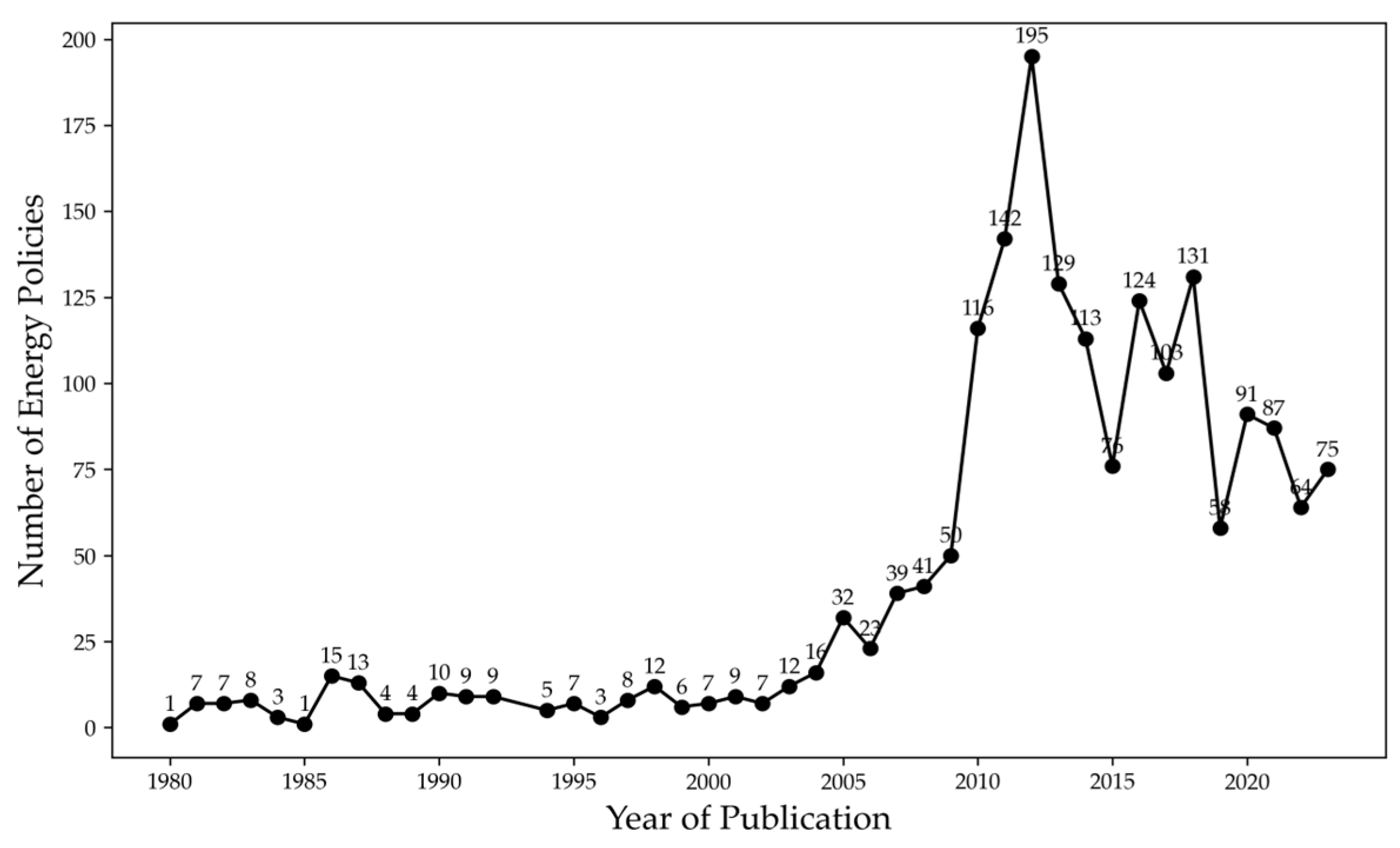
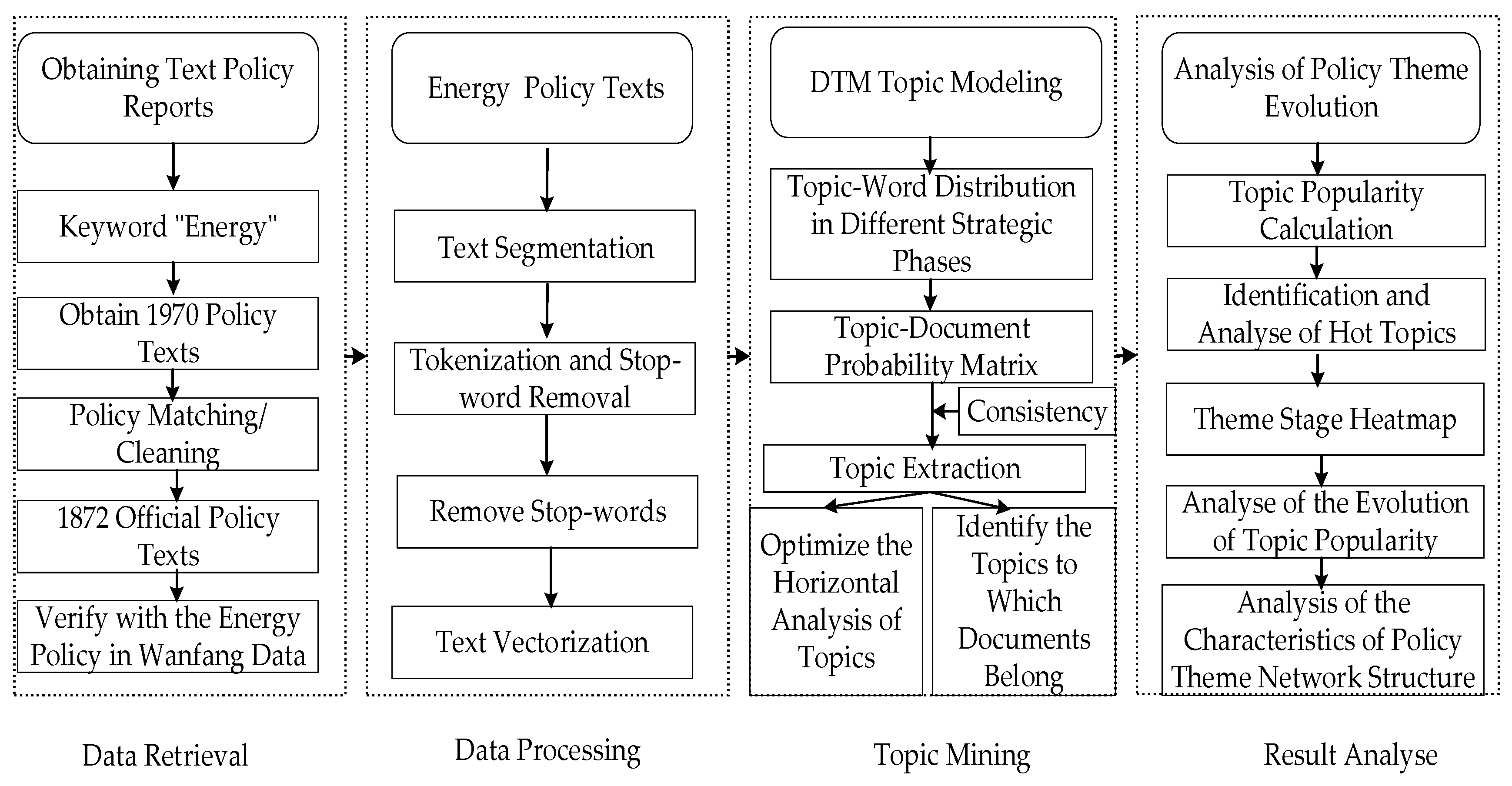

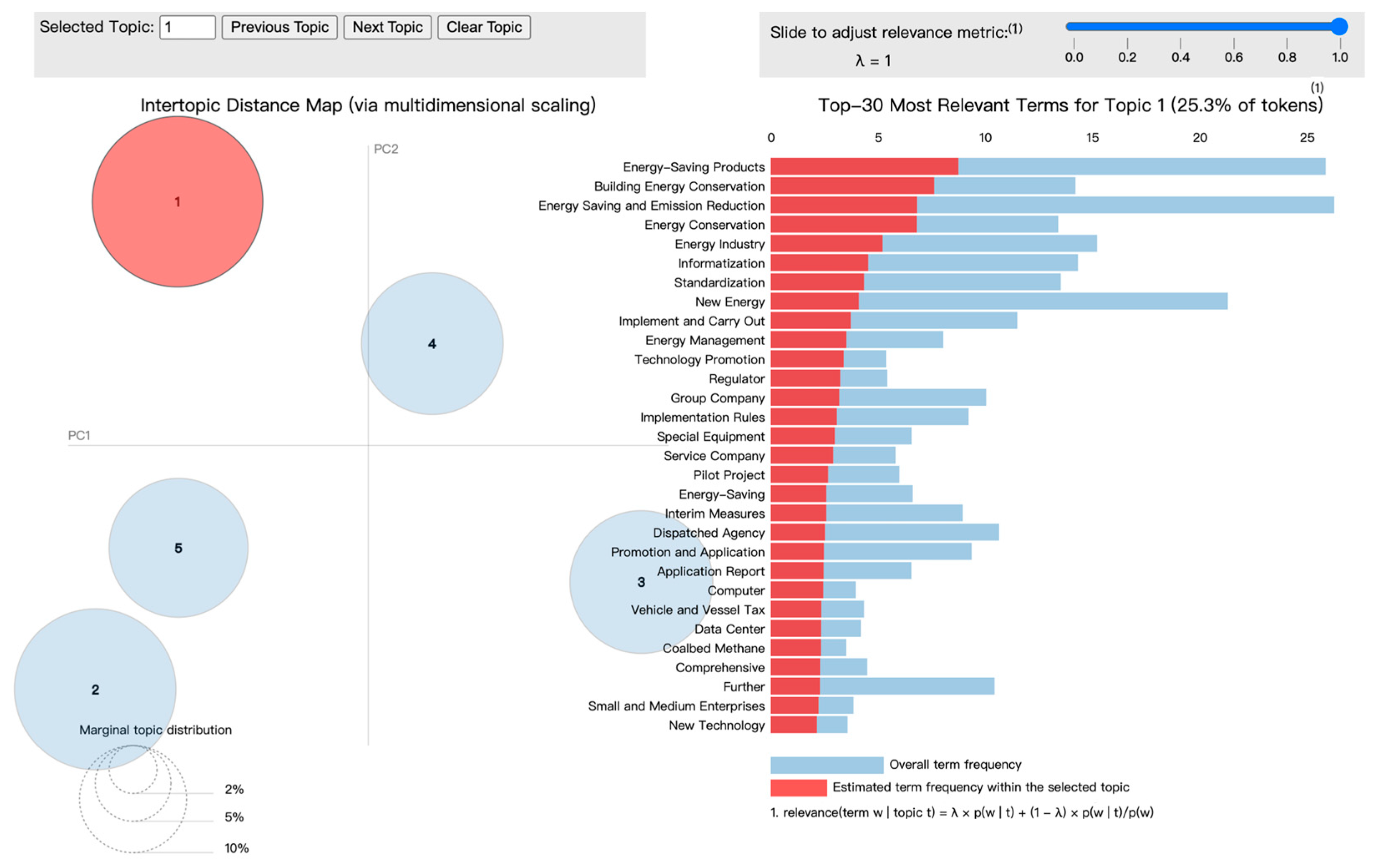
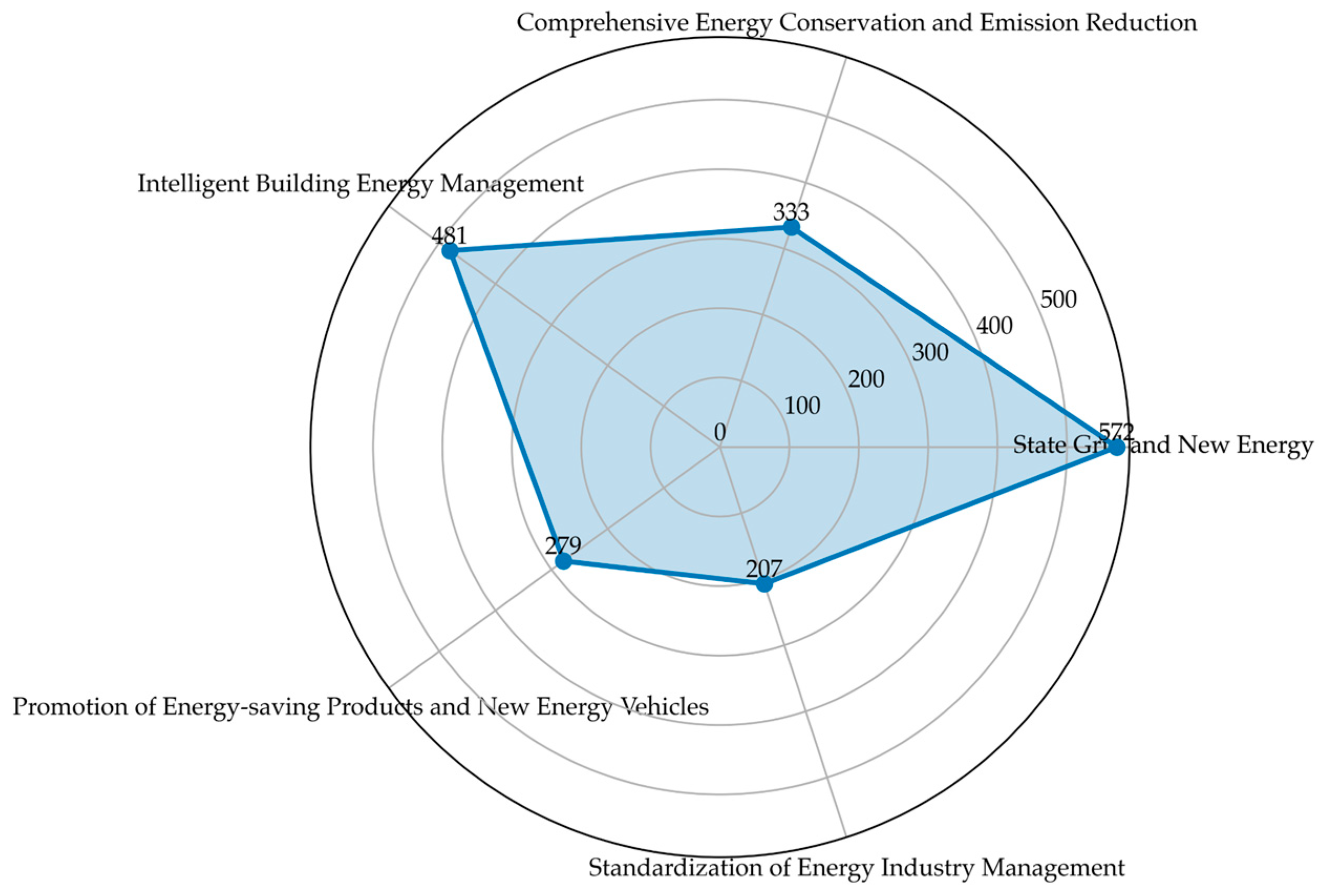
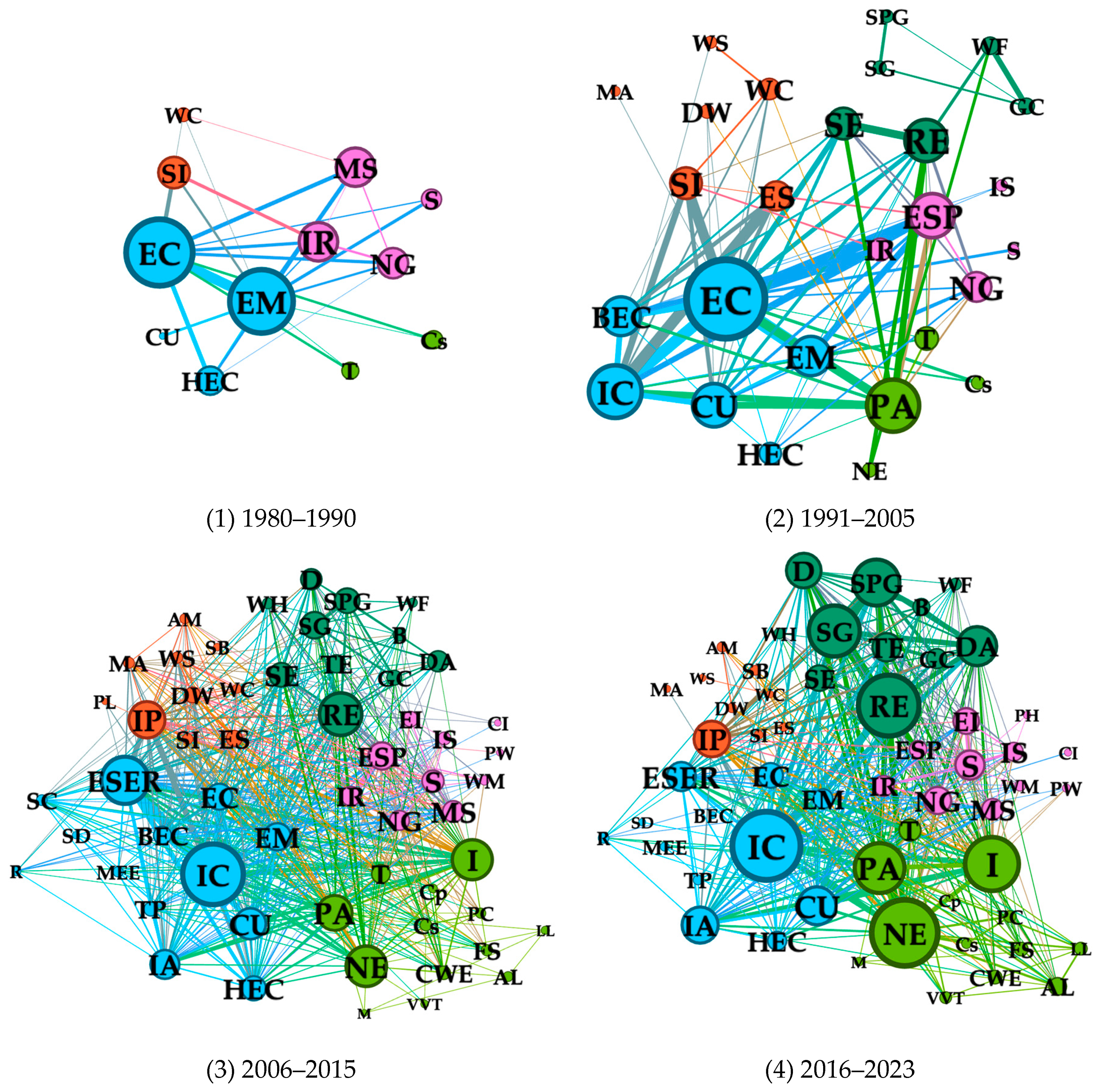
| Effectiveness Level | Number of Policies | Summary of Content |
|---|---|---|
| Departmental Working Documents | 1138 | Issued by various national ministries, such as the National Development and Reform Commission, Ministry of Industry and Information Technology, and Ministry of Finance. Focus on energy conservation, emission reduction, clean energy promotion, industrial safety, and environmental protection, aiming to advance green, low-carbon development and efficient resource utilization through targeted management and technical guidance. |
| Departmental Normative Documents | 537 | Issued by institutions like the National Energy Commission and Administrative Bureaus of the CPC Central Committee and the State Council. Cover regulations on energy-saving loans, surcharges for exceeding fuel quotas, tax treatments, standards for energy projects, and infrastructure funding, aimed at strengthening energy management and ensuring efficient and equitable energy use. |
| Ministerial Regulations | 70 | Include regulations on energy management and monitoring in sectors like energy and transportation. Key issuers include the Ministry of Energy and Ministry of Transportation, focusing on energy efficiency in power grids, transportation, and building sectors, promoting sustainable development through regulation and technical standards. |
| State Council Normative Documents | 56 | Broad energy and environmental policy guidelines covering oil consumption, coal utilization, biogas projects, small refinery management, energy saving, emission reduction, and new energy vehicle promotion. Jointly issued by the State Council and related departments, these documents guide energy use and environmental protection efforts. |
| Administrative Approvals | 25 | Issued by the National Energy Administration and Ministry of Industry and Information Technology, covering approvals for standardization committees, pilot projects, and safety registrations, ensuring standardized and safe industry practices. |
| Laws | 15 | Enacted by the Standing Committee of the National People’s Congress, including key laws like the Coal Law, Energy Conservation Law, Cleaner Production Promotion Law, Renewable Energy Law, and Circular Economy Promotion Law, ensuring comprehensive legal frameworks for energy management and environmental protection. |
| Others | 36 | Include administrative and group regulations, addressing standards and safety in power, coal, and gas industries, along with operational and oversight roles in national policies and resource conservation. |
| ID | Topics | Keywords |
|---|---|---|
| 1 | State Grid and New Energy | renewable energy, dispatched agency, group companies, new energy, State Grid, distributed, southern grid, solar energy, wind farms, energy industry |
| 2 | Comprehensive Energy Conservation and Emission Reduction | energy saving and emission reduction, dissemination week, water-saving, energy saving, implementation plan, seriously implement, transportation, water conservation, overachievement, storage battery |
| 3 | Intelligent Building Energy Management | building energy conservation, energy conservation, energy saving and emission reduction, informatization, energy management, comprehensive utilization, special device, service companies, energy-saving products, mechanical and electrical equipment |
| 4 | Promotion of Energy-Saving Products and New Energy Vehicles | energy-saving products, new energy, passenger cars, transportation, consumption, promotion and application, implementation rules, vehicle and vessel tax, financial subsidies, computers |
| 5 | Standardization of Energy Industry Management | standardization, energy industry, industry standards, management system, natural gas, washing machines, after review, implementation rules, energy-saving products, coal industry |
| Core Topic | Energy Strategy Initiation Stage | Energy Development Acceleration Stage | Critical Energy Transition Stage | Modern Energy System Optimization Stage | Topic Popularity |
|---|---|---|---|---|---|
| State Grid and New Energy | 0.096 | 0.217 | 0.213 | 0.444 |  |
| Comprehensive Energy Conservation and Emission Reduction | 0.101 | 0.149 | 0.233 | 0.117 | |
| Intelligent Building Energy Management | 0.485 | 0.41 | 0.291 | 0.148 | |
| Promotion of Energy-Saving Products and New Energy Vehicles | 0.114 | 0.081 | 0.168 | 0.142 | |
| Standardization of Energy Industry Management | 0.194 | 0.132 | 0.082 | 0.136 |
| Topic | Slope | p-Value | Type |
|---|---|---|---|
| State Grid and New Energy | 0.0098 | 0.0276 | Hot |
| Comprehensive Energy Conservation and Emission Reduction | −0.0068 | 0.0063 | Cold |
| Intelligent Building Energy Management | −0.0111 | 0.0009 | Cold |
| Promotion of Energy-Saving Products and New Energy Vehicles | 0.0048 | 0.0096 | Hot |
| Standardization of Energy Industry Management | 0.0033 | 0.0556 | - |
| Indicator | 1980–1990 | 1991–2005 | 2006–2015 | 2016–2023 |
|---|---|---|---|---|
| Sample Size | 72 | 142 | 924 | 733 |
| Network Size | 12 | 27 | 57 | 58 |
| Number of Network Relations | 27 | 91 | 616 | 547 |
| Network Connection Frequency | 165 | 560 | 8683 | 5720 |
| Network Cohesion Index | 0.13 | 0.106 | 0.108 | 0.126 |
| Overall Network Density | 0.409 | 0.259 | 0.386 | 0.331 |
| Average Node Distance | 1.591 | 0.254 | 1.638 | 1.717 |
Disclaimer/Publisher’s Note: The statements, opinions and data contained in all publications are solely those of the individual author(s) and contributor(s) and not of MDPI and/or the editor(s). MDPI and/or the editor(s) disclaim responsibility for any injury to people or property resulting from any ideas, methods, instructions or products referred to in the content. |
© 2024 by the authors. Licensee MDPI, Basel, Switzerland. This article is an open access article distributed under the terms and conditions of the Creative Commons Attribution (CC BY) license (https://creativecommons.org/licenses/by/4.0/).
Share and Cite
Wang, Z.; Zhou, R.; Wang, Y. DTM-Based Analysis of Hot Topics and Evolution of China’s Energy Policy. Sustainability 2024, 16, 8293. https://doi.org/10.3390/su16198293
Wang Z, Zhou R, Wang Y. DTM-Based Analysis of Hot Topics and Evolution of China’s Energy Policy. Sustainability. 2024; 16(19):8293. https://doi.org/10.3390/su16198293
Chicago/Turabian StyleWang, Zhanjie, Rufu Zhou, and Yongjian Wang. 2024. "DTM-Based Analysis of Hot Topics and Evolution of China’s Energy Policy" Sustainability 16, no. 19: 8293. https://doi.org/10.3390/su16198293
APA StyleWang, Z., Zhou, R., & Wang, Y. (2024). DTM-Based Analysis of Hot Topics and Evolution of China’s Energy Policy. Sustainability, 16(19), 8293. https://doi.org/10.3390/su16198293









